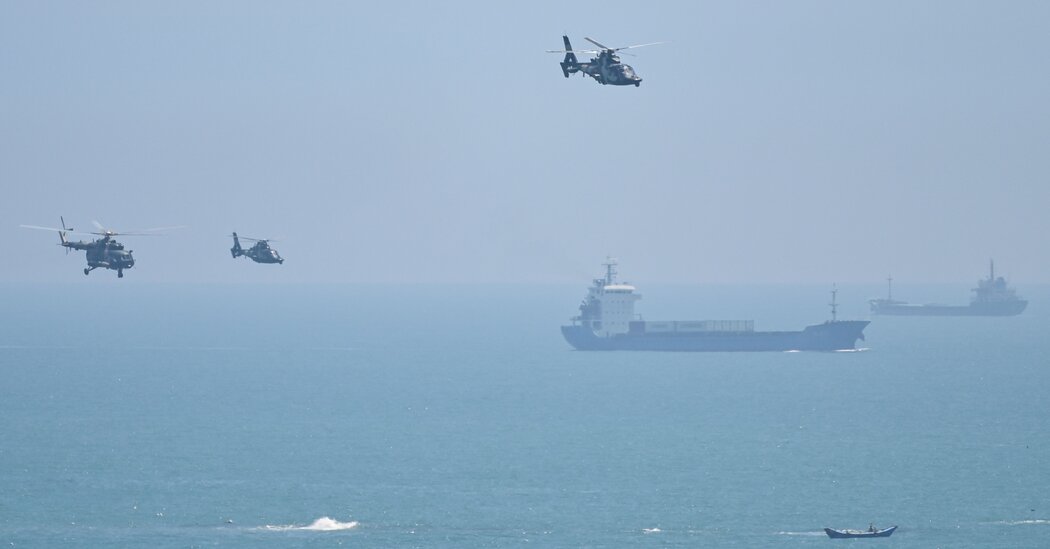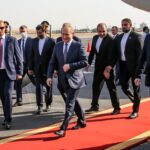
At least 11 Chinese missiles struck seas north, south and east of Taiwan on Thursday, less than 24 hours after Speaker Nancy Pelosi celebrated the island as a bulwark of democracy next to autocratic China. The People’s Liberation Army declared its missiles “all precisely hit their targets,” even as Japan said five landed in its waters.
The Chinese military called the exercises a prelude to a bigger show of force intended to punish the island for a visit by Ms. Pelosi that challenged Beijing’s claims to Taiwan. The drills, pushing ever closer to Taiwan and expected to run 72 hours, will also give Chinese forces valuable practice should they one day be ordered to encircle and attack the island.
China’s top leader, Xi Jinping, has said that he hopes to eventually unify Taiwan and China through peaceful steps, as part of his vision for a “rejuvenated” and powerful nation. But like his predecessors, he has not ruled out force, and China’s military buildup has reached a point where some commanders and analysts think an invasion is an increasingly plausible, though still highly risky, scenario.
Even if imminent conflict is unlikely, the exercises are putting the region on edge. And tensions could dangerously escalate, especially if something goes wrong, with the missiles landing near Japan seen as a message that China could hit the U.S. forces stationed there and intended as a warning to the government in Tokyo of the cost of its American alliance.
The Japanese government on Thursday said that five Chinese ballistic missiles had fallen into its exclusive economic zone, the first time any had landed in those waters.
Another missile, the government said, landed 50 miles northwest of Yonaguni, a small island at Japan’s southernmost tip and just a short distance from Taiwan; the missile did not land in Japan’s economic zone.
Japan lodged a protest with the Chinese government. “This is a grave issue that concerns our national security and the safety of the people,” said Japan’s defense minister, Nobuo Kishi.
At the White House, officials attempted a balance between showing that they would not be intimidated by the Chinese actions, while looking for ways to de-escalate. And that uneasy mix was evident in a series of announcements on Thursday afternoon.
John Kirby, a national security spokesman, said the Pentagon had ordered the U.S.S. Ronald Reagan to “remain on station” in the region, but some distance from the entrance to the Taiwan Strait, a more cautious move than President Bill Clinton made in the 1996 Taiwan crisis, when aircraft carriers moved closer to the action.
At the same time, Mr. Kirby said that the United States would resume “freedom of navigation” movements, transiting Navy ships through the Taiwan Strait — but was waiting several weeks, an indication the White House wants the current Chinese exercise to end first.
It is a strategy that has echoes of President Biden’s approach to Ukraine: Arm Taiwan, but do not put American troops directly in harm’s way.
The six areas for China’s exercises were chosen for their importance in a potential campaign to seal off Taiwan and repel foreign intervention, Maj. Gen. Meng Xiangqing, a professor of strategy at the National Defense University in Beijing, said in an interview on Chinese television.
One zone covers the narrowest part of the Taiwan Strait. Others could be used to block a major port or attack three of Taiwan’s main military bases. One facing southern Taiwan, “creates conditions to bolt the door and beat the dog,” he said, using a Chinese saying that refers to blocking an enemy’s escape route. He signaled that a bigger show of force using live ammunition was on the way.
Understand the China-Taiwan Tensions
What does China mean to Taiwan? China claims Taiwan, a self-governing island democracy of 23 million people, as its territory and has long vowed to take it back, by force if necessary. The island, to which Chiang Kai-shek’s Chinese forces retreated after the Communist Revolution of 1949, has never been part of the People’s Republic of China.
China’s main state-run television network, CCTV, stated that one of the missiles flew over Taiwan, marking another escalation of Chinese pressure on the island and risking serious miscalculation.
General Meng said the path was a first for China’s military.
“This is the first time that the military will hold a joint military operation around all of Taiwan island,” he said. “It should be said that although this is an exercise resembling actual combat, it can at any time turn into real combat.”
China’s outpouring of propaganda surrounding the drills, and an accompanying surge in nationalist sentiment, may be a welcome rallying point for Mr. Xi, the Communist Party leader. His march to an increasingly certain third term as leader at a party congress later this year has been weighed down by faltering economic growth, in large part caused by Covid outbreaks and Mr. Xi’s ferociously strict response to them.
But Mr. Xi has more than propaganda points at stake. Over the past eight years he has overhauled the People’s Liberation Army, accelerating its transition to an array of advanced forces capable of projecting Chinese power, including over Taiwan. The exercises could provide his commanders with valuable experience in joint operations of air, naval and rocket forces around the island.
“It’s not just about the messaging,” said Oriana Skylar Mastro, a fellow at the Freeman Spogli Institute for International Studies at Stanford University who studies China’s military and its potential to attack Taiwan. “Under the guise of signaling, they’re trying to basically test their ability to conduct complex maneuvers that are necessary for an amphibious assault on Taiwan.”
The United States has been encouraging regional allies to rally around Taiwan and has sped up efforts to improve the island’s defensive capabilities.
The American response on Thursday seemed to make clear Mr. Biden’s strategy: Demonstrating to Beijing that the United States was not going to be deterred from arming Taiwan, and also showing that the U.S. was not leaving the region — as President Donald J. Trump episodically threatened to do.
Privately, several officials wondered whether their message would get through. As one senior official said, there was some risk that by failing to move more naval forces into the region, the United States would be perceived by Mr. Xi as less committed to the region than Mr. Clinton was a quarter century ago.
Current and former Pentagon officials and military commanders said that China’s missile firings served both broad strategic purposes and specific operational goals.
The activity farthest east, they said, demonstrated China’s ability to cover the eastern approaches to Taiwan. “This has specific implications to any nation that would consider coming to the defense of Taiwan if force was used to reunify with P.R.C.,” said Adm. Scott H. Swift, a former U.S. Pacific Fleet commander, referring to China.
The missile launches in the northeast were designed specifically to send a message to Japan, the United States and Taiwan “based on the sensitivity to those waters to each,” the admiral said.
The activity in the southeast demonstrates China’s ability to disrupt maritime traffic in the Luzon Straits, Admiral Swift said, “a broad message to the international audience and specifically to the U.S. and Philippines as well as those that would consider coming to the defense of Taiwan.”
Finally, the exercise area in the Taiwan Strait demonstrates the ability to control maritime traffic in a crucial waterway.
“All demonstrate the P.R.C.’s ability to support a blockading force of Taiwan with missile fires,” the admiral said.
In an effort to avoid further stoking the growing tensions in the region, Defense Secretary Lloyd J. Austin III on Thursday postponed a routine intercontinental ballistic missile test.
A U.S. official said the delay, first reported by The Wall Street Journal, could last around 10 days. A delay that short is unlikely to affect military readiness but gives the Biden administration an opportunity to say it is making an effort to lower tensions.
The United States took a similar step in March when it delayed a missile launch amid simmering tensions with Moscow over its invasion of Ukraine.
The Pentagon’s decision drew sharp criticism from Republicans in Congress.
“How long does the administration intend to allow Vladimir Putin and Xi Jinping to dictate our missile-test schedule?” said Senator Tom Cotton, Republican of Arkansas.
It remains unclear how close Chinese forces will come to Taiwan during the rest of exercises, which are scheduled to end on Sunday.
In one possible sign of what to expect, China’s Eastern Theater Command, which encompasses Taiwan, said it was mobilizing more than 100 fighter planes, bombers and other aircraft, as well as more than 10 destroyers and frigates.
Twenty-two Chinese military aircraft briefly crossed the median line in the Taiwan Strait, an informal boundary that Chinese planes have crossed only infrequently, the Taiwanese defense ministry said.
The Chinese military could also test Taiwan’s responses by firing into the territorial waters directly off its coast.
“It signals that, since Taiwan is part of China, it doesn’t get a 12-nautical-mile zone,” said William Overholt, a senior research fellow at the Harvard Kennedy School, referring to the sea perimeter by which Taiwan defines its territorial waters. “Taiwan either has to defend its zone like an independent country or cave.”
One of the designated exercise zones lies off the eastern coast of Taiwan, at the farthest point from the Chinese mainland. When China held menacing military exercises off Taiwan during the crisis in 1996, the People’s Liberation Army, or P.L.A., did not go that far.
“It’s an intentional message meant to highlight the P.L.A.’s heightened capacity to project power farther from the Chinese mainland,” said Brian Hart, a fellow with the China Power Project at the Center for Strategic and International Studies.
Mr. Kirby suggested on Thursday that China had overreacted to Ms. Pelosi’s visit, and that it was up to Beijing to stop escalating tensions. He also acknowledged the situation could grow worse.
“The United States is prepared for what Beijing chooses to do,” Mr. Kirby said. “We will not seek, and do not want, a crisis. At the same time, we will not be deterred from operation in the seas and skies of the Western Pacific.”
Taiwan’s president, Tsai Ing-wen, called China’s exercises “irresponsible not only for Taiwan, but also for the international community” in a speech via video on Thursday night.
“We strictly demand that China be rational and self-restrained,” Ms. Tsai said.
After decades of tensions and several military crises with China, many on Taiwan have become inured to threats. But even if China does not take the most potentially incendiary steps this time, experts and officials on the island worry that the operations could spark an incident — a collision at sea or in the air, or a misfired missile — that inflames tensions into a full-fledged crisis.
“Previously, the Chinese Communists carried out military exercises at a distance, now they’ve become close-up,” Chang Yan-ting, a retired deputy commander of Taiwan’s air force, said in an interview. “They’re already at our doorstep.”
Ben Dooley, Jane Perlez, Helene Cooper, Zach Montague and John Liu contributed reporting. Claire Fu, Li You and Zixu Wang contributed research.




